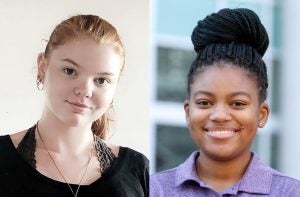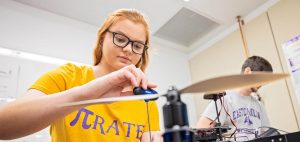ECU students showcase sound research at society meeting
Two East Carolina University mechanical engineering students presented research during the Acoustical Society of America’s 179th meeting Dec. 7-11.

Faith Cobb, left, and Nia Wilson recently presented research at the Acoustical Society of America meeting.
Juniors Faith Cobb and Nia Wilson presented their separate research projects during the virtual semi-annual meeting. Both student presentations were part of an overall project by Dr. Teresa Ryan, assistant professor in the Department of Engineering. Ryan is conducting research through a grant from the Office of Naval Research to help improve a numeric model that will inform commanders of an operation how close a ship can get to an enemy shoreline without being heard based on the atmospheric and sea conditions.
Cobb’s part of the project focuses on the acoustic properties of sand under various moisture levels.
“It was very exciting to have the opportunity to present the results of all my work and research over the past year,” Cobb said. “While the online conference format was, like many opportunities this year, not exactly what I had hoped it would be, it definitely inspired me to continue my research in order to present in person in the future.”
Cobb said the research fascinates her.
“Traveling to several study locations along the coast and witnessing firsthand how various atmospheric and topographical conditions affect how sound is perceived has piqued my interest in continuing with this research,” she said. “I am also excited about the opportunity to participate in research that will eventually be used to protect those serving in our military.”

Faith Cobb works on a drone in a lab last year. (ECU Photo by Cliff Hollis)
Cobb said the next step in the research would be the collection of sand samples from natural beaches to better understand the impact water content in sand has on the propagation of sound. It’s an effort she is looking forward to, especially considering the coronavirus pandemic is limiting in-person classes on campus.
“Participating in engineering research has provided many opportunities for hands-on learning that I normally would not get in the classroom, especially with the current state of affairs,” she said.
Wilson’s research focuses on temperature and sound.
“The heat from the sun makes the air very close to the ground substantially warmer than up in the air,” Wilson said. “Current sound loudness predictions don’t account for that thin warmer layer of air. My work measured the actual temperature profiles to compare how different sound loudness predictions would be using the real measured numbers or the simple assumptions currently used.”
Wilson said the science involved in the research interests her, but “I also like to connect this to just everyday aspects of life, like how everything sounds quieter on a snowy day because of not only the cold temperatures, but also the snow on the ground absorbing the sound, so you get into how the shape of the land affects how sound waves move.”
She called the opportunity to present her research during the meeting exciting.

Nia Wilson sets up sound equipment on the West Research Campus. (Photo by Ken Buday)
“The research I am doing yielded some pretty cool results, and to be able to make sense of those results and share them with others is really cool,” Wilson said. “It’s also exciting to show other people the work that has been done in the last couple of months and how using something as simple as a drone and a couple of sensors can tell you a lot about the relationship between temperature and elevation.”
Wilson said she would continue to collect data and hopes to get a paper on her research published, grateful for the opportunity to conduct research as an undergraduate student.
“It makes me excited about my career path as an engineer,” she said. “Before this research, I was not sure if being an engineer was right for me or if it was something I really wanted to do, but now I can confidently say that this is where I belong. Participating in this research has also given me a chance to apply what I have been learning in class to real-life situations, which is cool.”
Founded in 1929, the Acoustical Society of America is an international organization with the goal of generating, disseminating and promoting the knowledge of acoustics and its applications.
— Ken Buday